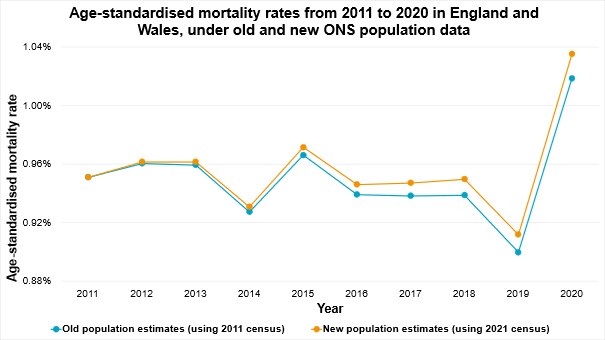Guest Blog: 2021 Census indicates little improvement in mortality in the last decade
Stuart McDonald, Ben Rees and Matthew Derham, actuarial experts at Lane, Clark and Peacock LLP, explain the ONS population overestimates and what the revised calculations mean for mortality rates in the UK.
Census 2021
Each year, the Office for National Statistics (ONS) provides population estimates for England and Wales. These estimates are usually derived by rolling forward from the most recent census, using data on births, deaths and estimated migration over the period. The initial population estimates for the years 2012 to 2020 were based on the 2011 census.
However, when the 2021 census was analysed, the ONS realised that their estimates had overestimated the population – the estimates contained almost 300,000 more people than indicated by the 2021 census[1]. The differences were not uniformly spread, with some ages impacted more than others. There were broadly two groups of impacted ages:
- younger ages where migration has a larger impact. For those under aged 30, the census showed 2% fewer people than previously thought.
- pensioner ages where small inaccuracies from the 2011 census had compounded into bigger errors when projected forward[2]. Above age 70, the 2021 census showed 1% fewer people than had been estimated. Above age 90 this grew to almost 4% fewer people!
Impact on Mortality Rates
Population estimates are important for the calculation of mortality rates. At their heart, mortality rates are a relatively simple calculation – for each age we divide the number of deaths by the number of people who were alive. Accurate death data is collected on an ongoing basis by the ONS and was not impacted by the 2021 census, meaning only the bottom of this fraction changed. There is an inverse relationship between mortality rates and population estimates – if the population estimate goes down, the mortality rate goes up.
That’s exactly what the 2021 census showed. So plugging in the new lower population estimates showed that mortality rates over the inter-census period were higher than had previously been thought. Not only that, but at the oldest ages where mortality rates at are their highest, the difference was even more acute.
Visualising the Change
The graph below shows an average mortality rate (using a method known as “age-standardisation”) for the population of England and Wales, calculated using the old and new population estimates (i.e. new estimates that had been recalibrated to the 2021 census).

As can be seen from the chart, over time the mortality rates diverge and by 2020, the upwards revision required was around 1.5%.
What are the Implications?
Over hundreds of years, mortality rates have been falling and people have been living ever longer. Experts were already concerned that improvements in England and Wales had largely stalled in the 2010s, with previous estimates showing improvements of around 0.5% per annum (compared to over 2% per annum over the previous decade). When the new population data is incorporated, around of a third of the apparent improvement is shown to be illusory, leaving almost no improvement at all in the decade leading up to the Covid-19 pandemic.
A legacy of the pandemic is that our healthcare system, which was already struggling to keep pace with the demands of an ageing population, is now facing unprecedented pressure. This is shown by increasing waiting lists, extended ambulance response times and long delays accessing accident and emergency units. Death rates in 2023 remain above pre-pandemic levels[3] and actuaries are increasingly pessimistic[4] about the extent to which mortality will improve in the future.
Conclusion
This new ONS data following the 2021 Census highlights the extent to which mortality rates in England and Wales were already stagnating in the decade leading up to the Covid-19 pandemic. The extraordinary current pressures on the healthcare system are only exacerbating an existing problem. This illustrates the challenges faced in trying to ensure healthier longer lives for a growing and ageing population. But stagnation of progress is not inevitable – improvements in public health and a focus on prevention of illness could add life to our years and years to our lives.
[1] Population estimates for England and Wales – Office for National Statistics (ons.gov.uk)
[2] Phantoms Never Die: Living with Unreliable Population Data — Heriot-Watt Research Portal (hw.ac.uk)
[3] https://www.thelancet.com/journals/lanepe/article/PIIS2666-7762(23)00221-1/fulltext
[4] CMI_2022 shows half-year drop in cohort life expectancy (actuaries.org.uk)

Stuart McDonald, Ben Rees and Matthew Derham
Actuarial experts at Lane, Clark & Peacock LLP
